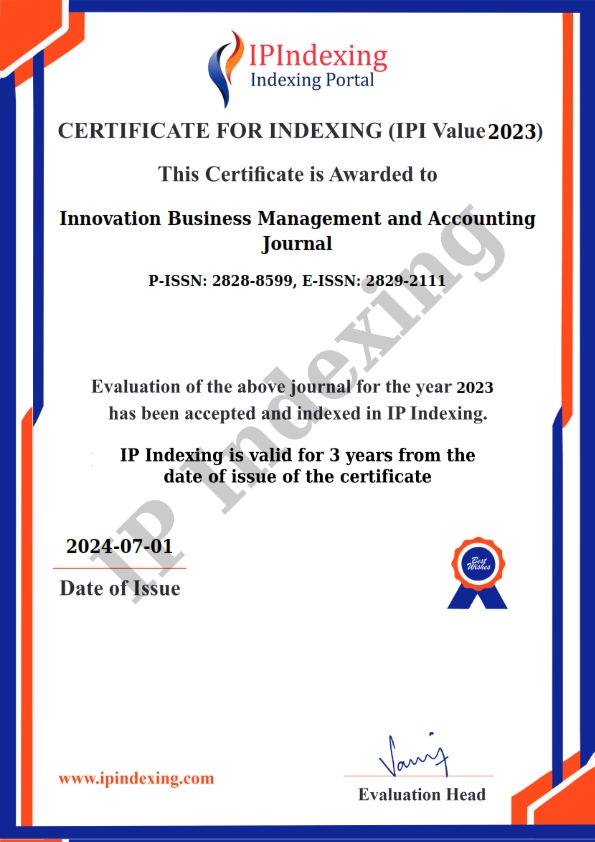The Importance of Leadership Style, Characteristics and Work Environment for Creating Members' Performance
DOI:
https://doi.org/10.56070/ibmaj.2024.018Keywords:
Individual Characteristics, Leadership Style, Performance, Work EnvironmentAbstract
partial effects of leadership style, individual characteristics, and work environment on the performance of Bogor Search and Rescue Air Unit personnel. This study also aims to determine which elements in leadership style, individual traits, and work environment influence members' performance in the Bogor Search and Rescue Air Unit. The research population and sample include 73 members of the Bogor Search and Rescue Air Unit who will be studied as a whole. This study employed descriptive analysis to assess the frequency distribution of respondents' answers to questionnaire results, as well as multiple linear regression analysis. The study's findings indicate that leadership style, individual traits, and work environment all have an impact on performance, both simultaneously and partially. This study found that leadership style has a significant impact on the performance. According to the findings of this study, the leadership style used should be charismatic or transformational, with a focus on members' individual character abilities and the implementation of a sense of openness between members and leaders of the Bogor Search and Rescue Air Unit, as well as the establishment of brotherly relationships among members.
Downloads
References
Afandi, P. (2016). Concept & indicator human resources management for management research. Deepublish.
Asat, A., & Subyantoro, A. (2020). The mediation role of motivation in enhancing performance: the impact of individual characteristics and compensation. Journal of Islamic Economics Lariba, 6(2), 169-190.
Dharmanegara, I. B. A., Sulistyan, R. B., & Agustina, I. (2021). How Well Public Service Motivation and Job Satisfaction in Enhancing the Effect of Compensation on Job Performance? Wiga : Jurnal Penelitian Ilmu Ekonomi, 11(2), 181-192. https://doi.org/10.30741/wiga.v11i2.853
Diamantidis, A. D., & Chatzoglou, P. (2019). Factors affecting employee performance: an empirical approach. International journal of productivity and performance management, 68(1), 171-193. https://doi.org/10.1108/IJPPM-01-2018-0012
Goleman, D. (2017). Leadership that gets results. In Leadership perspectives (pp. 85-96). Routledge.
Hussain, M., & Hassan, D. H. (2016). The leadership styles dilemma in the business world. International Journal of Organizational Leadership, 5, 411-425.
Kotlar, J., De Massis, A., Wright, M., & Frattini, F. (2018). Organizational goals: Antecedents, formation processes and implications for firm behavior and performance. International Journal of Management Reviews, 20, S3-S18. https://doi.org/10.1111/ijmr.12170
Rifa, M. N., Sukidjo, S., & Efendi, R. (2019). The Performance of Employees Influenced by Leadership Styles and Compensation. International Journal of Multicultural and Multireligious Understanding, 6(6), 581-587. http://doi.org/10.18415/ijmmu.v6i6.1243
Saputra, G. W., Kurniawati, Johan, A., & Sulistyan, R. B. (2023). Analysis of Employee Performance Improvement: The Role of Social Exchange Theory. Wiga : Jurnal Penelitian Ilmu Ekonomi, 13(2), 272-281.
Senge, P. M. (2017). The leaders new work: Building learning organizations. In Leadership perspectives (pp. 51-67). Routledge.
Shet, S. V., Poddar, T., Samuel, F. W., & Dwivedi, Y. K. (2021). Examining the determinants of successful adoption of data analytics in human resource management–A framework for implications. Journal of Business Research, 131, 311-326. https://doi.org/10.1016/j.jbusres.2021.03.054
Sulistyan, R. B. (2017). Kontribusi Kepemimpinan dan Lingkungan Kerja dalam Meningkatkan Motivasi Pegawai. Jurnal Ilmu Manajemen Advantage, 1(2), 166-177. https://doi.org/10.30741/adv.v1i2.196
Sulistyan, R. B., Carito, D. W., Cahyaningati, R., Taufik, M., Kasno, K., & Samsuranto, S. (2022). Identification of Human Resources in the Application of SME Technology. Wiga : Jurnal Penelitian Ilmu Ekonomi, 22(1), 70-76. https://doi.org/10.30741/wiga.v12i1.799
Sulistyan, R. B., Paramita, R. W. D., Setyobakti, M. H., Rizal, N., & Lukiana, N. (2020). Perceived Organizational Support on Employee Performance: The Mediating Effect of Job Stress. Proceedings of the 1st International Conference on Social Science, Humanities, Education and Society Development. https://doi.org/10.4108/eai.13-10-2020.2303710
Tampi, B. J. (2014). Pengaruh Gaya Kepemimpinan dan Motivasi terrhadap Kinerja karyawan pada PT. Bank Negara Indonesia, tbk (regional sales manado). Acta Diurna Komunikasi, 3(4), 1-20.
Thoha, M. (2012). Organizational Behavior Basic Concepts and Implications. PT Raja Grafindo Persada.
Truong, Y., Mazloomi, H., & Berrone, P. (2021). Understanding the impact of symbolic and substantive environmental actions on organizational reputation. Industrial Marketing Management, 92, 307-320. https://doi.org/10.1016/j.indmarman.2020.05.006
Widodo, S. E. (2015). Manajemen Pengembangan Sumber Daya Manusia. Pustaka Pelajar.
Downloads
Published
How to Cite
Issue
Section
License
Copyright (c) 2024 Dito Sigit Kuncoro, Harianto Respati, Mokhamad Nasir

This work is licensed under a Creative Commons Attribution-ShareAlike 4.0 International License.



